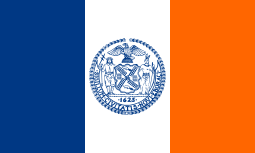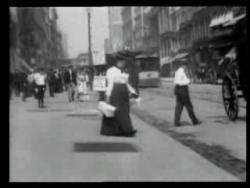23rd Street (Manhattan)
|
West 23rd Street from the High Line, 2013 | |
| Maintained by | NYCDOT |
|---|---|
| Length | 1.9 mi[1] (3.1 km) |
| Location | Manhattan, New York City |
| Postal code | 10011, 10010 |
| Coordinates | 40°44′32″N 73°59′28″W / 40.7421°N 73.9911°WCoordinates: 40°44′32″N 73°59′28″W / 40.7421°N 73.9911°W |
| West end | Eleventh Avenue in Chelsea |
| East end |
|
| North | 24th Street |
| South | 22nd Street |
| Construction | |
| Commissioned | March 1811 |
23rd Street is a broad thoroughfare in the New York City borough of Manhattan, one of the major two-way, east-west streets in the borough's grid. As with Manhattan's other "crosstown" streets, it is divided at Fifth Avenue, in this case at Madison Square Park, into its east and west sections. Since 1999 the area north of 23rd Street around the park has been referred to as Nomad.[2][3][4] The street formerly ran from the East River to the Hudson River, but now terminates at 11th Avenue.
History
The street was designated by the Commissioners' Plan of 1811 that established the Manhattan street grid as one of 15 east-west streets that would be 100 feet (30 m) in width (while other streets were designated as 60 feet (18 m) in width).[5]
West 23rd Street

West 23rd carves through the heart of Chelsea. For much of the late 19th century and early 20th century its western end was site of the Pavonia Ferry at Pier 63, just north of the Chelsea Piers. London Terrace is slight farther inland. In the late 19th century, the western part of 23rd Street was to American theater what Broadway is today, with the Opera House Palace and Pike's Opera House one block away and Proctor's Theater[6] ("continuous daily vaudeville") across the street from the Hotel Chelsea. 23rd Street remained New York's main theater strip until The Empire opened on Broadway some twenty blocks uptown, ushering in a new era of theater.
The Hotel Chelsea, New York's first co-op apartment complex, was built here in 1883; it was New York's tallest building until 1902.[7] Sid Vicious and Nancy Spungen lived in the Hotel Chelsea from August 1978.[8] Spungen was stabbed to death in the bathroom of her room at the Hotel Chelsea in October 1978.[8]
The block of 23rd Street between Fifth and Sixth Avenues is part of the Ladies' Mile Historic District.

East 23rd Street
East 23rd Street, which runs between Fifth Avenue and the East River (FDR Drive), is a main street of Manhattan's neighborhood of Gramercy Park. The Metropolitan Life Insurance Company (MetLife), headquartered at 1 Madison Avenue at East 23rd Street, played a significant role in shaping the character of development along East 23rd Street in the early 20th century.
Opposite Madison Square Park on East 23rd Street are two skyscrapers originally built by MetLife. 1 Madison Avenue, with its ornate clocktower face, was one of Manhattan's first skyscrapers.[9] 11 Madison Avenue was intended to be the base of a much taller skyscraper, but the onset of the Depression forced MetLife to scale back its plans. Even so, the building stands today as an Art Deco masterpiece.
Peter Cooper Village, one of MetLife's experiments in middle-income community building (until bought by Tishman Speyer). Peter Cooper Village was a sister project to MetLife's Stuyvesant Town, which was built across 20th Street to the south.[10]
On the far east end of East 23rd are Stuyvesant Cove Park, the Asser Levy Public Baths,[11] and a parking garage now used as a gas station.
On October 17, 1966, this street was also witness to New York's deadliest fire in terms of firefighters killed until the September 11 attacks. The "23rd Street Fire", as it came to be called, began in a cellar at 7 East 22nd Street and soon spread to the basement of 6 East 23rd Street, a five-story commercial building that housed a drugstore at street level. Twelve firefighters were killed; two chiefs, two lieutenants, and six firefighters plunged into the flaming cellar, while two more firefighters were killed by the blast of flame and heat on the first floor.[12]

The Flatiron Building is on the south side of the street at Broadway. The origin of the term "23 skidoo" is said to be from wind gusts caused by the building's triangular shape or hot air from a shaft through which immense volumes of air escaped, producing gusts that supposedly lifted women's skirts.[note 1]
-

The east end of the street, the East River
-
Hot air gusts and a woman's skirt. Possible origin of the term "23 skidoo". Circa 1901
Public transit
Every New York City Subway line that crosses 23rd Street has a local station there:
- 23rd Street on the BMT Broadway Line serving the N Q R W trains
- 23rd Street on the IND Eighth Avenue Line serving the A C E trains
- 23rd Street on the IND Sixth Avenue Line serving the F M trains
- 23rd Street on the IRT Broadway – Seventh Avenue Line serving the 1 2 trains
- 23rd Street on the IRT Lexington Avenue Line serving the 4 6 <6> trains
Port Authority Trans-Hudson has a station at 23rd Street as well.
In the past, every former IRT elevated line had a station at 23rd Street, most of which were local stations:
- 23rd Street on the IRT Second Avenue Line
- 23rd Street on the IRT Third Avenue Line which served local and express trains
- 23rd Street on the IRT Sixth Avenue Line
- 23rd Street on the IRT Ninth Avenue Line
Additionally, MTA New York City Transit's M23 bus runs the length of 23rd Street. This replaced the horse-drawn and later electric-powered Twenty-Third Street Railway. In 2003, the Straphangers Campaign listed the M23 as one of the slowest in the city, winning its "Pokey Award."
See also
- List of numbered streets in Manhattan
- 2016 New York and New Jersey bombings
-
 New York City portal
New York City portal
References
Notes
- ↑ Dolkart, Andrew S. "The Architecture and Development of New York City: The Birth of the Skyscraper - Romantic Symbols". Columbia University. Retrieved May 15, 2007.
In the early twentieth century, men would hang out on the corner here on Twenty-third Street and watch the wind blowing women's dresses up so that they could catch a little bit of ankle. This entered into popular culture and there are hundreds of postcards and illustrations of women with their dresses blowing up in front of the Flatiron Building. And it supposedly is where the slang expression "23 skidoo" comes from because the police would come and give the voyeurs the 23 skidoo to tell them to get out of the area.
Citations
- ↑ Google (August 31, 2015). "23rd Street (Manhattan)" (Map). Google Maps. Google. Retrieved August 31, 2015.
- ↑ Louie, Elaine (August 5, 1999). "The Trendy Discover NoMad Land, And Move In". The New York Times. Archived from the original on 30 July 2010. Retrieved July 4, 2010.
- ↑ Feirstein, Sanna (2002). Naming New York: Manhattan Places and How They Got Their Names. New York: New York University Press. p. 103. ISBN 0-8147-2712-3.
- ↑ Sternbergh, Adam (April 11, 2010). "Soho. Nolita. Dumbo. NoMad? Branding the last unnamed neighborhood in Manhattan". New York. Retrieved July 4, 2010.
- ↑ Morris, Gouverneur, De Witt, Simeon, and Rutherford, John [sic] (March 1811) "Remarks Of The Commissioners For Laying Out Streets And Roads In The City Of New York, Under The Act Of April 3, 1807", Cornell University Library. Accessed June 27, 2016. "These streets are all sixty feet wide except fifteen, which are one hundred feet wide, viz.: Numbers fourteen, twenty-three, thirty-four, forty-two, fifty-seven, seventy-two, seventy-nine, eighty-six, ninety-six, one hundred and six, one hundred and sixteen, one hundred and twenty-five, one hundred and thirty-five, one hundred and forty-five, and one hundred and fifty-five--the block or space between them being in general about two hundred feet."
- ↑ RKO Proctor's Twenty-Third Street Theatre, 139 West 23rd Street, New York, NY 10011 Cinema Treasures
- ↑ Chamberlain, Lisa (June 19, 2007). "Change at the Chelsea, Shelter of the Arts". The New York Times. Retrieved September 19, 2008.
- 1 2 Schoemer, Karen. "The Day Punk Died" New York (magazine) October 19, 2008.
- ↑ Matlins, Melissa. "Metropolitan Life Insurance Tower". Skyscraper Museum. Retrieved July 4, 2010.
- ↑ "Urban Apartment Dwelling Builds Momentum, 1930-1950". On-Line Residential. Retrieved July 4, 2010.
- ↑ "Asser Levy Recreation Center". Reed Construction Data. Retrieved July 4, 2010.
- ↑ O'Donnell, Michelle (October 17, 2006). "Oct. 17, 1966, When 12 Firemen Died". The New York Times. Retrieved August 7, 2008.
External links
| Wikimedia Commons has media related to 23rd Street (Manhattan). |
- New York Songlines: 23rd Street – a virtual walking tour
- History of the Hotel Chelsea
- The 23rd Street Fire

